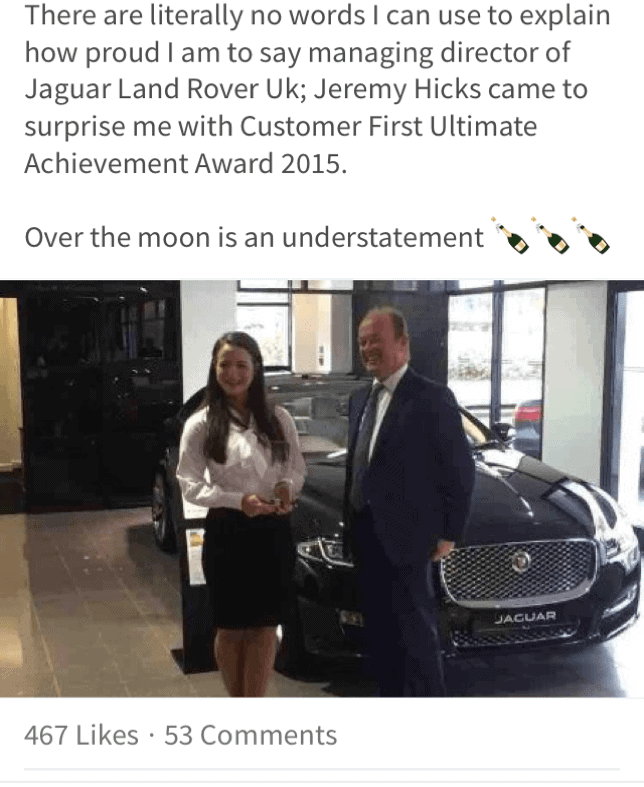How 5 Companies Bring their Values to Life
In order to challenge what you are doing in your place of work, sometimes it’s necessary to take a step back and “bring the outside in”. Here are a few examples, from a collection of many we compiled for a recent study, that might inspire you to identify innovative ways of embedding your own values:
Toms Shoes: Community-Minded
Giving back to communities in need underpins Toms’ whole raison d’etre. Created in 2006, the company matches every pair of shoes purchased with a pair of new shoes given to a child in need, and now does the same with Toms Eyewear. Employees are also able to experience the One for One™ strategy first-hand, seeing how their work is helping those less fortunate around the world. For employees and target customers who are more altruistically-motivated, creating this strong sense of meaning and purpose drives high levels of loyalty and engagement.
Jaguar Land Rover: Grateful
Recognition is known to be a powerful motivator for people to do their best work and go the extra mile. Companies have come a long way since the days that the Parker pen was presented at an employee’s 25th anniversary, and many think extremely creatively about reward and recognition. A surprise visit or phone call directly from a leader in the organisation has a ripple effect throughout the company, and social media guarantees the news is shared extensively. That the CEO of Jaguar Land Rover would make the time; find it important enough; and directly connect with a junior employee, breaks down barriers of hierarchy and underlines that everyone’s individual effort is important and noticed.

Morning Star: Autonomy
Established in 1970, this US manufacturer of tomato products has always maintained a philosophy of Self-Management, and employees take a personal responsibility for achieving the company’s Mission. The company enables flexible hours and autonomy through the use of a CLOU – Colleague Letter of Understanding – and staff operate without an organisational chart, formal hierarchy, job titles or job descriptions. Each colleague indicates in this CLOU his/her work schedule commitment; and members of the team know each other’s commitments. If someone needs more time off for any reason, they manage this within their teams, and without management approval. The financial impact speaks for itself, and the company has grown to provide 40% of US tomato manufactured products.
Arup: Innovation
A culture which values innovation and creativity gives rise to exciting products & services which push across perceived boundaries. Arup is arguably the world’s most creative engineering and design company, with the Sydney Opera House, Centre Pompidou, and the Beijing Water Cube, amongst the iconic buildings it has created. Arup’s employees work in collaboration with all the stakeholders of a project, including mathematicians, economists, artists, and even politicians. The company sees the combination and friction of different skill sets and personalities as its cultural strength and the key to its strategy. “We want there to be interesting parts that don’t quite fit in…that take us places where we didn’t expect to get to,” says Chairman Philip Dilley. “That’s part of my job now—to prevent it from becoming totally orderly.”
Zappos: Individuality
In her blog, Siobhan Sheridan, HR Director at NSPCC, questions how she has gone about embedding organisational values in the past:
“I realised the number of times over the years that I have run programs rolling out organisational values, competencies, behaviours, leadership frameworks. And I wondered whether I hadn’t been responsible for asking people to ‘become’ something that they are not.” [1]
It’s an interesting point. By defining and embedding the values and culture of an organisation, we are surely simplifying and clarifying? We are making clear to people in the company what behaviours are acceptable, or expected. We are making it easier for prospective employees to decide whether they want to join us. We’re making it simpler for the hiring manager to decide if they’d fit in. Sometimes a particular company or culture just isn’t right for someone. Right?
There’s a lot to be said, however, for being free to express one’s individuality. It will enhance two of the three core facets of engagement – affective and social – as well as increasing loyalty.
Zappos’ take on individuality is clear. They actively encourage their employees to be themselves and express their individuality. They believe in “a little weirdness”. Their Culture Book, first produced in 2014, uses arresting imagery and insights from their employees to paint a picture of what the culture really feels like [2].
An employee of 5 years remarks on individuality; which is not a stated core value, but instead underpins everything:
“Looking back on who I was when I started and who I am today, I realize something interesting; I’m the same person, ALMOST. This place doesn’t force you to compromise who you are for the work, but instead does the opposite. It’s as if I’m myself, but at a higher vibration.”
Zappos Insights strives to inspire other companies to develop and strengthen their own unique cultures, believing strongly that culture comes first and drives everything else. A brief insight into each of these 5 companies reveals that organisational culture is as unique and multi-faceted as the individuals who work there. It can’t be boiled down to a list of corporate values, though these are a good starting point. It is how the values are expressed and who that attracts that really shapes a culture and makes it something which gives you sustainable competitive advantage.
We work with many clients to align Values & Culture with Organisational Purpose and Strategy. To find out more about our work, or to discuss your particular challenges, please contact us.
Related Starboard articles:
Why You Need to Nurture Your Culture, click here
Signs of High-Performing Organisational Cultures, click here
[1] Siobhan Sheridan, Blog: Modern Day Body Snatchers, March 2016.
[2] Zappos Culture Book.
Photo by Ian Schneider on Unsplash
© Cath Longfield, Starboard

